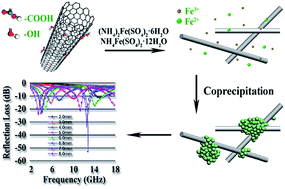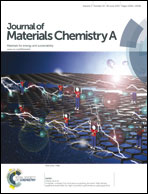3D Fe3O4 nanocrystals decorating carbon nanotubes to tune electromagnetic properties and enhance microwave absorption capacity†
Abstract
We fabricated a novel dielectric–magnetic nanostructure by hybridizing 3D Fe3O4 nanocrystals and multi-walled carbon nanotubes through a simple co-precipitation route. The 3D Fe3O4-MWCNTs composites demonstrate enhanced microwave absorption with tunable strong-absorption wavebands in the frequency range of 2–18 GHz. Double-band microwave absorption appears in the investigated frequency range and at various thicknesses. This depends on the loading concentration of 3D Fe3O4-MWCNTs. Minimum reflection loss values at 20 wt% loading of −23.0 dB and −52.8 dB are observed at 4.1 GHz and 12.8 GHz, respectively, which are superior to those of pure MWCNTs as well as other hybrids of Fe3O4. The improved absorption capacity arises from the synergy of dielectric loss and magnetic loss, as well as the enhancement of multiple interfaces among 3D Fe3O4 nanocrystals. All of these factors increase the flexibility of tuning microwave absorption. These results provide a new strategy to tune electromagnetic properties and enhance the capacity of high-efficient microwave absorbers.


 Please wait while we load your content...
Please wait while we load your content...